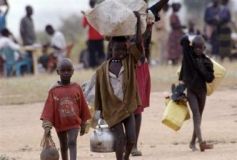Obstacles limit return of south Sudan displaced
May 17, 2006 (KHARTOUM) — A year and a half after Sudan’s north-south peace deal, ambitious plans for the return of millions of displaced people are being quashed by a host of physical and financial obstacles.
 Since the January 2005 peace agreement that ended more than two decades of deadly fighting between Khartoum and the Sudan People’s Liberation Movement, only a fraction of the four million displaced have headed back to their homes.
Since the January 2005 peace agreement that ended more than two decades of deadly fighting between Khartoum and the Sudan People’s Liberation Movement, only a fraction of the four million displaced have headed back to their homes.
Robert Turner, who heads the UN mission in Sudan’s Return, Reintegration and Recovery (RRR) unit, put the figure at 500,000.
The autonomous government of south Sudan had set itself a target of repatriating another half million displaced people during the dry seasons of 2006 alone, allocating 24 million dollars for transport costs.
But the United Nations asked the authorities to downscale the programme in the face of serious logistical problems in a country covering 2.5 million square kilometres (almost one million square miles), the largest in Africa.
“They lowered the number from 500,000 to 150,000 but that’s not possible either.
“It’s not realistic to do it in this calendar year because a lot of the overland routes won’t be fully passable almost until the end of this year,” Turner told AFP in an interview.
A Western diplomat explained that the southern government wanted mass repatriations in order to swell the electorate ahead of the general elections that could take place as early as 2008.
The scrapping of the current executive was enshrined in the peace accord with Khartoum.
The southern authorities have also sought to speed up the return of the displaced — notably the estimated two million who live in and around Khartoum — as the labour is needed to rebuild the devastated region, Turner said.
“We are not encouraging returns,” he quickly added. But short of being able to regulate them, the United Nations has decided to assist the returns in a bid to prevent a new humanitarian crisis.
Yet the world body — which is conducting the world’s largest humanitarian operation in Sudan — suffers from a dire shortage of funds, with only 11 of the 80 million dollars budgeted for RRR paid so far.
The journey itself can be perilous for the families going back to the south, as evidenced in April when three people were killed in an accident involving a barge taking hundreds of them across the Nile.
Further threats await those who make it back home before they can resume a normal life.
“Landmines, the absence of any basic infrastructure and insecurity” are only some of them, said the World Health Organisation’s Jean Rigal.
The estimated five million landmines sown in south Sudan during the 21 years of civil war continue to kill and maim people, as do marauding Ugandan militias from the ultra-violent Lord’s Resistance Army.
Sudan’s 10 southern states — which are among the poorest regions in the world — are starting from scratch.
They lack schools, hospitals, roads and housing, while poor sanitation has facilitated outbreaks of cholera and meningitis that have affected 15,000 people since the start of the year.
The international community had rallied behind the cause of south Sudan, vowing to bankroll its reconstruction and pledging 600 million dollars at a donor conference in Oslo in April 2005.
“The money is ready to go but donors stressed it was very important it was well spent, while as a matter of fact we are dealing with an infrastructural vacuum,” the Khartoum-based Western diplomat said.
He argued this state of affairs affected both equipment and manpower. “The south has brilliant technocrats at the top and community leaders at the grass roots but nothing in between.”
(ST)
